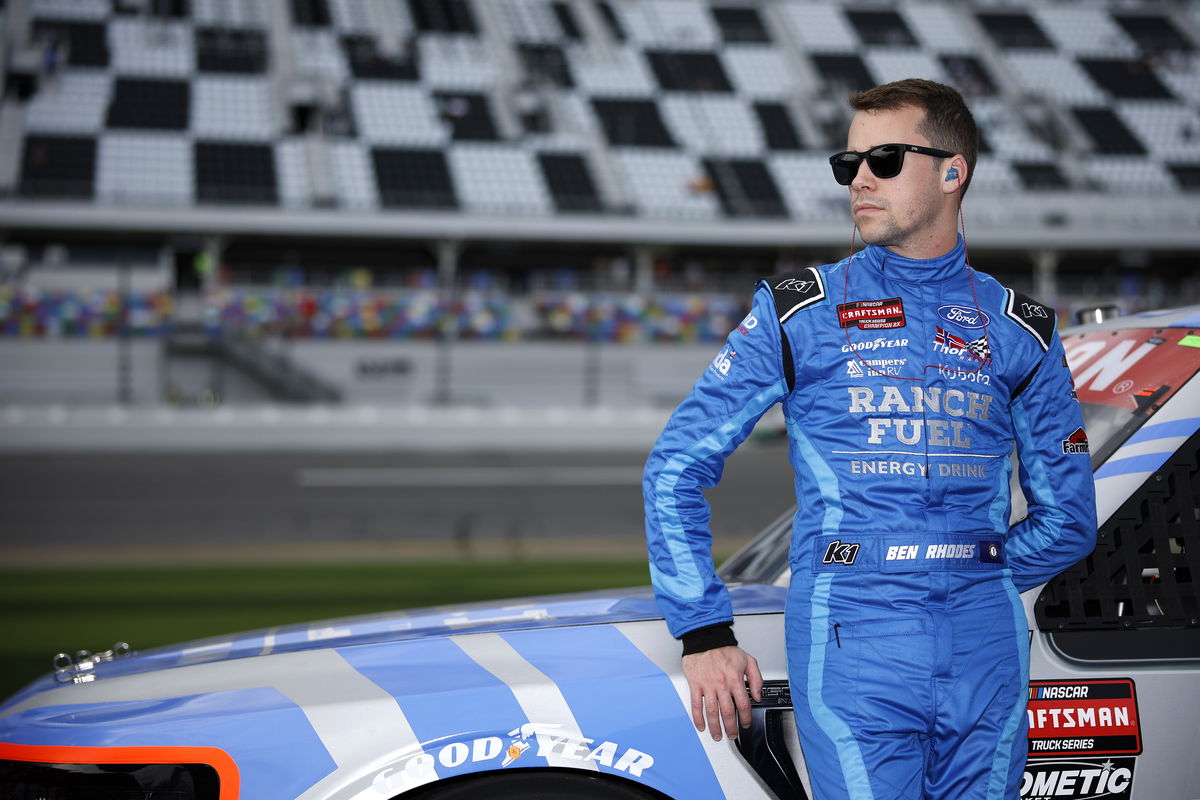
Getty
DAYTONA BEACH, FLORIDA – FEBRUARY 16: Ben Rhodes, driver of the #99 Ranch Fuel Energy Drink Ford, waits on the grid during qualifying for the NASCAR Craftsman Truck Series Fresh from Florida 250 at Daytona International Speedway on February 16, 2024 in Daytona Beach, Florida. (Photo by James Gilbert/Getty Images)

Getty
DAYTONA BEACH, FLORIDA – FEBRUARY 16: Ben Rhodes, driver of the #99 Ranch Fuel Energy Drink Ford, waits on the grid during qualifying for the NASCAR Craftsman Truck Series Fresh from Florida 250 at Daytona International Speedway on February 16, 2024 in Daytona Beach, Florida. (Photo by James Gilbert/Getty Images)
In the heat of summer, Watkins Glen International was transformed from the serene hills of upstate New York into a relentless proving ground for the NASCAR Craftsman Truck Series. The 2025 Mission 176 was more than another race—it was survival, as engines ruptured and wheels flew amid a backdrop of playoff pressure and mechanical carnage. Ben Rhodes, 2021 Truck Series champion and perennial playoff contender, found himself in a garage echoing with the aftermath of a scene lined with broken axles, battered trucks, and somber faces.
Watch What’s Trending Now!
Rhodes had just wrestled through the most difficult twenty laps of his career, feeling his truck’s rear end bucking wildly as he navigated brutal G-forces and towering curbs on a course where “tough” is standard and mercy is rare. Amid these hardships, and with his playoff fate hanging by a thread, he looked to his team and delivered an eight-word plea that would encapsulate the chaos and heartbreak of the day.
ADVERTISEMENT
Ben Rhodes reflects on the chaotic Glen aftermath
Ben Rhodes’s race at Watkins Glen unraveled as dramatically as the rest of the field. Having battled through unpredictable handling all afternoon, he could sense trouble brewing, something off in the rear end of his T Sport Ford F-150 lap after lap. “For most of the race, actually, I felt… I felt something going on… and then finally, the last twenty laps… of the most difficult truck I’ve ever driven… You know, on throttle, the rear end moves one way… off throttle, goes another way… so it’s just really difficult to hang on to,” Rhodes recounted in the garage after the incident.
Then, disaster struck with no warning. Between turns six and seven, his left rear wheel detached, sending him hard into the wall in a moment both sudden and irrevocable. Rhodes’s succinct yet telling words to his team, “I just wanna finish the race right now,” carried more weight than any elaborate explanation. It was a raw, unfiltered plea for relief in the face of mounting adversity, encapsulating the emotional toll of a violent mechanical failure and the loss of crucial stage points.
No hard feelings between @tannergray5 and @TyMajeski as the pair talked and agreed on who was at fault for their late-race tangle. #NASCAR pic.twitter.com/iNbg55ye9q
— Frontstretch (@Frontstretch) August 9, 2025
ADVERTISEMENT
Rhodes, who entered the race tied with teammate Jake Garcia for the final playoff transfer spot, found his strategy and season-defining effort slipping away. “All I need to do is finish in front of them… which I think we could have done… and yeah… now all that work’s out the window.” Beyond Rhodes’s misfortune, Watkins Glen became a minefield for competitors-axles snapped, engines died, and blown tires left others stranded.
Rhodes highlighted the circuit’s brutality: “Watkins Glen is tough… the curves are massive… a lot of G-forces… and it’s the fastest… I mean… we ran here once… but we’re considerably faster than last time… qualifying speeds were way up… it’s tough on the trucks.” Even as stage points were salvaged, Rhodes won Stage 2 for a vital 10 points. His hopes now pivot to Richmond, where he’s faced with an 11-point deficit to erase in one final bid for playoff redemption.
ADVERTISEMENT
Watkins Glen’s mechanical mayhem: G-forces, speed, and the cost of victory
The chaos Rhodes experienced was not an outlier but emblematic of the day’s relentless attrition. Watkins Glen’s notoriously punishing layout, with its massive curbs and shifting grip, did more than test driver skill; it strained the trucks’ mechanical integrity to breaking point. Overtimes became the norm as multiple incidents forced repeated restarts. Corey Heim ultimately survived three overtimes to claim victory, but the pathway was littered with calamity: flames ended the day for Toni Breidinger, engines expired without warning, and crashes sent trucks spinning through every sector.
“I got behind on that last stage,” Heim said post-race. “I was scratching and clawing, trying to get back through the field. … I had my brakes pretty much go out completely on me on that long green-flag run. I blew the bus stop, and I made a lot of mistakes myself.” Stage points emerged as the strategic lifeline for playoff-chasers. With many drivers pitting out of sequence or staying out on worn tires simply to grab any available points, each lap was tighter, each fight fiercer.
ADVERTISEMENT
Mechanical failures could not always be attributed solely to preparation; sometimes the G-loads and the demands of ruthless lap-by-lap speed simply overcame the trucks, as Rhodes observed, reflecting on his hub mishap. The results sheet from Watkins Glen will forever chronicle the winners, but beneath the statistics lies a race defined by heartbreak, resilience, and the poignant eight-word plea from one former champion: the drive to survive, finish, and fight another day.
ADVERTISEMENT
ADVERTISEMENT
ADVERTISEMENT

